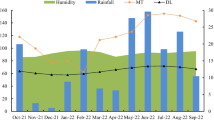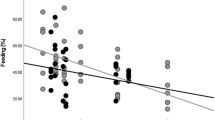Abstract
We present the first field study of activity budgets, diet and ranging patterns of the Sulawesi crested black macaque, Macaca nigra, one of seven macaque species endemic to Sulawesi, Indonesia. We studied three crested macaque groups, ranging in size from 50 to 97 individuals, for 18 months in the Tangkoko-DuaSudara Nature Reserve, North Sulawesi. They spent 59% of the day moving and procuring food, especially fruits, and 41% of the day resting and socializing. Their diet is composed of more than 145 species of fruit (66% of observed feeding bouts), vegetative material (2.5%), invertebrates (31.5%), and occasional vertebrate prey. Group differences were more pronounced than seasonal or diurnal differences. Specifically, the largest group moved farther during the day, moved at a faster and more uniform rate, ate less fruit, rested more, and socialized less than the smaller groups did. The largest group had the largest home range, but it included less primary forest and more disturbed habitat than the ranges of smaller groups. There are individual differences in activity budgets of adult males and females in time spent moving, resting, feeding, and socializing that may reflect differences in reproductive strategies of males versus females. The behavior of large juveniles is more similar to that of adults than to that of small juveniles. Daily movements and use of home range are correlated with diet. Macaques moved shorter distances as the proportion of time spent feeding on fruit increased, and the top four dietary items accounted for most of the variance in entry into hectare blocks of home range.
Similar content being viewed by others
Explore related subjects
Discover the latest articles and news from researchers in related subjects, suggested using machine learning.REFERENCES
Albrecht, G. H. (1978). The craniofacial morphology of the Sulawesi macaques. Contrib. Primatol. Vol. 13, S. Karger, Basel.
Altmann, J. (1974a). Observational study of behavior: Sampling methods. Behavior 49: 227–265.
Altmann, S. (1974b). Baboons, space, time, and energy. Am. Zool. 14: 221–248.
Altmann, J. (1980). Baboon Mothers and Infants, Harvard University Press, Cambridge, MA.
Barton, R. A., Whiten, A., Strum, S. C., Byrne, R. W., and Simpson, A. J. (1992). Habitat use and resource availability in baboons. Anim. Behav. 43: 831–844.
Bernstein, I. S., and Baker, S. C. (1988). Activity patterns in a captive group of Celebes black apes (Macaca nigra). Folia Primatol. 51: 61–75.
Boinski, S. (1987). Habitat use by squirrel monkeys (Saimiri oerstedi) in Costa Rica. Folia Primatol. 49: 151–167.
Butynski, T. M. (1990). Comparative ecology of blue monkeys (Cercopithecus mitis) in high-and low-density subpopulations. Ecol. Monogr. 60: 1–26.
Chapman, C. A., Wrangham, R. W., and Chapman, L. J. (1995). Ecological constraints on group size: An analysis of spider monkey and chimpanzee subgroups. Behav. Ecol. Sociobiol. 36: 59–70.
Cheney, D. L. (1977). The acquisition of rank and the development of reciprocal alliances among free-ranging immature baboons. Behav. Ecol. Sociobiol. 2: 303–318.
Chivers, D. J. (1974). The siamang in Malaya. Contrib. Primatol. Vol. 4, S. Karger, Basel.
Ciani, A. C., Stanyon, R., Scheffrahn, W., and Sampurno, B. (1989). Evidence of gene flow between Sulawesi macaques. Am. J. Primatol. 17: 257–270.
Clutton-Brock, T. H. (ed.). (1977). Primate Ecology, Academic Press, London.
Clutton-Brock, T. H. (1977). Some aspects of intraspecific variation in feeding and ranging behavior in primates. In Clutton-Brock, T. H. (ed.), Primate Ecology, Academic Press, London.
Clutton-Brock, T. H., and Harvey, P. (1977). Species differences in feeding and ranging behavior in primates. In Clutton-Brock, T. H. (ed.), Primate Ecology, Academic Press, London.
Davidge, C. (1978). Activity patterns of chacma baboons (Papio ursinus) at Cape Point. Zool. Afr. 13: 329–350.
Dittus, W. (1977). The social regulation of population density and age-sex distribution in the toque monkey. Behavior 63: 281–322.
Eisenberg, J. F., Muckenhirn, N. A., and Rudran, R. (1972). The relation between ecology and social structure in primates. Science 176: 863–874.
Fooden, J. (1969). Taxonomy and evolution of the monkeys of the Celebes (primates: Cercopithecidae). Biblio. Primatol. 10, S. Karger, Basel.
Fooden, J., and Lanyon, S. M. (1989). Blood-protein allele frequencies and phylogenetic relationships in Macaca: A review. Am. J. Primatol. 17: 209–214.
Fragaszy, D. M., and Boinski, S. (1995) Patterns of individual diet choice and efficiency of foraging in wedge-capped capuchin monkeys (Cebus olivaceus). J. Comp. Psychol. 109: 1–10.
Groves, C. P. (1980). Speciation in Macaca: The view from Sulawesi. In Lindburg, D. G. (ed.), The Macaques: Studies in Ecology, Behavior and Evolution, Van Nostrand Reinhold, New York.
Hadama, Y., Suryobroto, B., Takanaka, O., Iwamoto, M., Watanabe, T., and Kawamoto, Y. (1985) Distribution of three species of macaque in the northern peninsula of Sulawesi. Kyoto Univ. Overseas Res. Rep. Stud. Asian Non-Hum. Primates 6: 19–30.
Hadidian, J. (1985). Yawning in an Old World monkey, Macaca nigra (Primates: Cercopithecidae). Behavior 75: 133–147.
International Union for the Conservation of Nature (1991). Atlas of Tropical Rainforests, IUCN, Gland, Switzerland.
Janson, C. J. (1984). Female choice and mating system of the brown capuchin monkey Cebus apella. Z. Tierpsychol. 65: 177–200.
Kawamoto, Y., Takenaka, O., Suryobroto, B., and Brotoisworo, E. (1985). Genetic differentiation of Sulawesi macaques. Kyoto Univ. Overseas Res. Rep. Stud. Asian Non-Hum. Primates 5: 41–61.
Kinnaird, M. F. (1990). Behavioral and Demographic Response to Habitat Change by the Tana River Crested Mangabey (Cercocebus galeritus galeritus), Unpublished Ph.D. dissertation, University of Florida, Gainesville.
Kinnaird, M. F., and O'Brien, T. G. (1994). Intergroup interactions in Macaca nigra: A random walk or resource defense. Proceedings of the XV Congress of the International Primatological Society (abstract).
Kinnaird, M. F., O'Brien, T. G., and Suryadi, S. (1996). Population fluctuation in Sulawesi red-knobbed hornbills: Tracking figs in space and time. Auk 113: 431–440.
Klein, L. L., and Klein, D. J. (1977). Feeding behavior of the Columbian spider monkey, Ateles belzebuth. In Clutton-Brock, T. H. (ed.), Primate Ecology, Academic Press, London.
Kohlhaas, A. K. (1993). Behavior and Ecology of Macaca nigrescens: Behavioral and Social Responses to the Environment and Fruit Availability, Unpublished Ph.D. dissertation, University of Colorado, Boulder.
Kurup, G. U., and Kumar, A. (1992). Time budget and activity patterns of the lion-tailed macaque (Macaca silenus). Int. J. Primatol. 14: 27–39.
Lawes, M. J., and Piper, S. E. (1992). Activity patterns in free-ranging Samango monkeys (Cercopithecus mitis ertyhrarchus Peters, 1852) at the southern range limit. Folia Primatol. 59: 186–202.
Leighton, M. (1993). Modeling dietary selectivity by Bornean orangutans: Evidence for integration of multiple criteria in fruit selection. Int. J. Primatol. 14: 257–313.
Lowen, C., and Dunbar, R. I. M. (1994). Territory size and defendability in primates. Behav. Ecol. Sociobiol. 33: 347–354.
Mitani, J. C., and Rodman, P. (1979). Territoriality: the relation of ranging pattern and home range size to defendability with an analysis of territoriality among primate species. Behav. Ecol. Sociobiol. 5: 241–251.
Norconk, M. A., and Kinzey, W. G. (1994). Challenge of Neotropical frugivory: Travel patterns of spider monkeys and bearded sakis. Am. J. Primatol. 34: 171–183.
Oates, J. F. (1987). Food distribution and foraging behavior. In Smuts, B. B., Cheney, D. L., Seyfarth, R., Wrangham, R. W., and Struhsaker, T. T. (eds.), Primate Societies, Chicago, University of Chicago Press.
Oates, J. F., Whitesides, G. H., Davies, A. G., Waterman, P. G., Green, S. M., DaSilva, G. L., and Mole, S. (1990). Determinants of variation in tropical forest primate biomass: New evidence from Africa. Ecology 71: 328–343.
O'Brien, T. G. (1991). Female-male social interactions in wedge-capped capuchin monkeys: Benefits and costs of group living. Anim. Behav. 41: 555–567.
O'Brien, T. G., and Kinnaird, M. F. (1994). Preliminary observations on fruit patch choice in Macaca nigra. Proceedings of the XV Congress of the International Primatological Society (abstract).
O'Brien, T. G., and Kinnaird, M. F. (1996). Declining populations of mammals and birds of North Sulawesi. Oryx 30: 150–156.
O'Brien, T. G., and Robinson, J. G. (1991). Allomaternal care by female wedge-capped capuchin monkeys: Effect of age, rank and relatedness. Behavior 119: 30–50.
O'Brien, T. G., and Robinson, J. G. (1993). Stability of social relationships in female wedge-capped capuchin monkeys. In Periera, M., and Fairbanks, L. (eds.), Juvenile Primates: Life History, Development and Behavior, Oxford University Press, New York.
Post, D. (1981). Activity patterns of yellow baboons (Papio cynocephalus) in the Amboseli National Park, Kenya. Anim. Behav. 29: 357–374.
Post, D., Hausfater, G., and McCuskey, S. (1980). Feeding behavior of yellow baboons (Papio cynocephalus): Relationship to age, gender and dominance rank. Folia Primatol. 34: 170–195.
Reed, C. R., O'Brien, T. G., and Kinnaird, M. F. (1997). Male social behavior and dominance hierarchy in the Sulawesi crested black macaque (Macaca nigra). Int. J. Primatol. 18: 247–260.
Richard, A. F., Goldstein, S. J., and Dewar, R. E. (1989). Weed macaques: The evolutionary implications of macaque feeding ecology. Int. J. Primatol. 10: 569–594.
Robinson, J. G. (1986). Seasonal variation in use of time and space by the wedge-capped capuchin monkey, Cebus olivaceus: Implications for foraging theory. Smithson. Contrib. Zool. 431: 1–60.
Rosenbaum, B. (1996). Patterns and Determinants of Abundance for the Sulawesi Crested Black Macaque (Macaca nigra) on Bacan Island, Indonesia, with Notes on Its Conservation, Unpublished Ph.D. dissertation, University of Colorado, Boulder.
Rosenbaum, B., Kinnaird, M. F., and O'Brien, T. G. (1996). Population densities of Sulawesi crested black macaques (Macaca nigra) on Bacan and Sulawesi, Indonesia: Effects of habitat disturbance and hunting (submitted for publication).
Seyfarth, R. M. (1977). A model of social grooming among adult female monkeys. Anim. Behav. 24: 917–938.
Seyfarth, R. M. (1978). Social relationships among adult male and female baboons, 1. Behavior during sexual consortships. Behavior 64: 204–226.
Sokal, R. R., and Rohlf, F. J. (1981). Biometry, Freeman Press, San Francisco.
Struhsaker, T. T., and Leland, L. (1979). Socioecology of five sympatric monkey species in the Kibale Forest, Uganda. Adv. Stud. Behav. 9: 159–228.
Sugardjito, J., Southwick, C. H., Supriatna, J., Kohlhaas, A., Baker, S., Erwin, J., Froelich, K., and Lerche, N. (1989). Population survey of macaques in Northern Sulawesi. Am. J. Primatol. 18: 285–301.
Terborgh, J. (1983). Five New World Primates: A Study in Comparative Ecology, Princeton University Press, Princeton, NJ.
Thierry, B. (1984). Clasping behavior in Macaca tonkeana. Behavior 89: 1–28.
Thierry, B. (1990). Feedback loop between kinship and dominance: The macaque model. J. Theor. Biol. 145: 511–521.
Thierry, B., Anderson, J. R., Demaria, C., and Petit, O. (1994). Tonkean macaque behavior from the perspective of the evolution of Sulawesi macaques. Curr. Primatol. 2: 103–117.
Thorington, R. W., and Groves, C. P. (1970). An annotated classification of the Cercopithecoidea. In Napier, J. R., and Napier, P. H. (eds.), Old World Monkeys: Evolution, Systematics and Behavior, Academic Press, New York.
Walters, J. R., and Seyfarth, R. M. (1987). Conflict and cooperation. In Smuts, B. B., Cheney, D. L., Seyfarth, R., Wrangham, R. W., and Struhsaker, T. T. (eds.), Primate Societies, University of Chicago Press, Chicago.
Waser, P. (1975). Monthly variations in the feeding and activity of the mangabey, Cercocebus albigena. E. Afr. Wildl. J. 13: 249–265.
Waser, P., and Wiley, R. H. (1979). Mechanism and evolution of spacing in animals. In Marler, P., and Vandenburg, J. G. (eds.), Handbook of Behavioral Neurobiology, 3 (Social Behavior and Communication), Plenum Press, New York.
White, G. C., and Garrot, R. A. (1990). Analysis of Wildlife Radio-Tracking Data, Academic Press, New York.
Wrangham, R. W. (1980). An ecological model of female-bonded primate groups. Behavior 75: 262–300.
Author information
Authors and Affiliations
Rights and permissions
About this article
Cite this article
O'Brien, T.G., Kinnaird, M.F. Behavior, Diet, and Movements of the Sulawesi Crested Black Macaque (Macaca nigra). International Journal of Primatology 18, 321–351 (1997). https://doi.org/10.1023/A:1026330332061
Issue Date:
DOI: https://doi.org/10.1023/A:1026330332061




